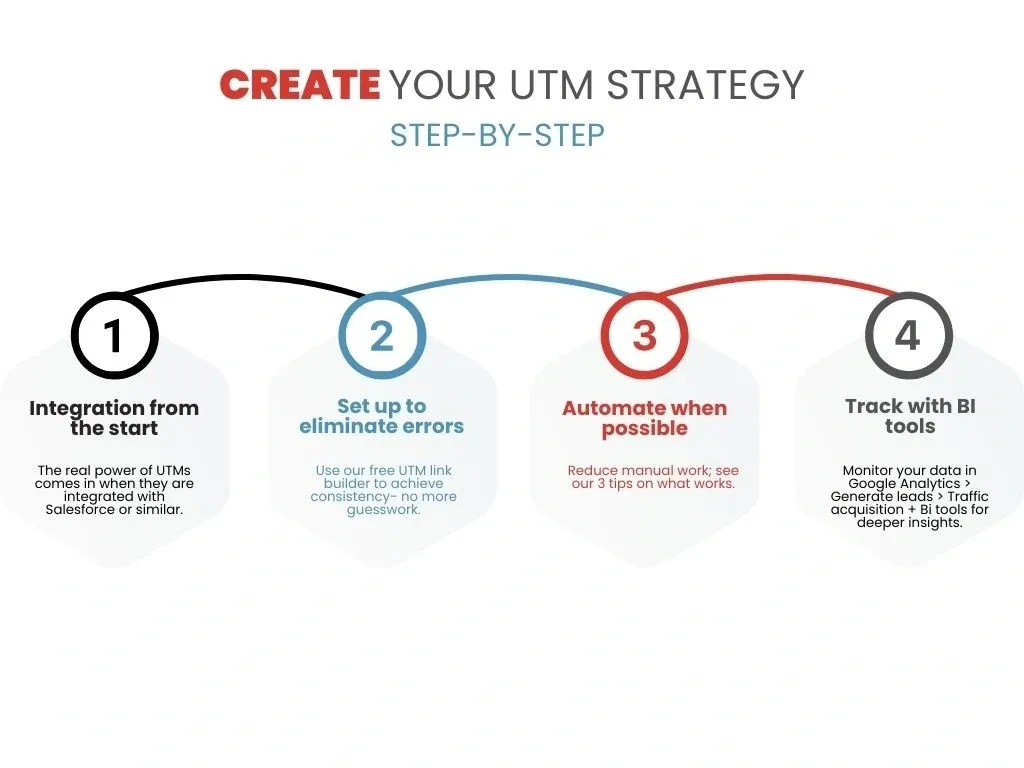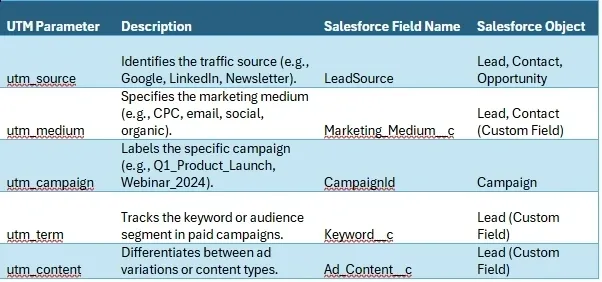The marketing data mirage
You’re running a campaign, utilizing social media, email, and some strategic guest posts or other content pieces woven through various channels. Traffic is flowing in, and your Google Analytics dashboard is flashing numbers like a neon sign. But wait…where did that traffic actually originate from?
Your Facebook ad results are lumped into “Direct Traffic.” Your email click-throughs vanish into the abyss of “Other.” You know LinkedIn is effective, but you can’t prove it.
Behold the humble yet mighty UTM links, a secret weapon for cutting through the haze of ambiguous traffic data.
UTM links: The DNA of your marketing attribution
UTM (Urchin Tracking Module) parameters are snippets of text added to your URLs that will tell you exactly where your traffic comes from. With the appropriate structure, they can answer questions such as:
- Which social platform is driving actual conversions?
- Are your paid LinkedIn ads outperforming organic efforts in terms of the quality of prospects they generate?
- Does your email newsletter create more revenue-generating opportunities than your pay-per-click campaigns? (i.e. lower Customer Acquisition Costs, improved Lifetime Value of prospects and customers and better Return On Investment).
- Which media partnership is bringing in the best quality leads?
Yet, despite all this potential, UTMs are often misused, neglected, and even ignored completely. The result? Marketers operate with limited visibility, tracking only the engagement data (without understanding how their activities contribute to conversions) and making a mixture of gut-driven and experience-based decisions about where to allocate their precious marketing budget and their team’s time.
The chaos of untracked traffic
Picture this: Your lab instrumentation company invests significantly in content marketing. You’ve published high-value, research-backed whitepapers, several blogs, social media content, perhaps an infographic or two, along with some videos. You’ve promoted them across multiple channels. Six months in, your traffic has increased, but you only have a partial understanding of which efforts are effective.
- Your social media manager swears that LinkedIn is where your best quality leads are coming from, but without UTMs, you can’t prove it.
- The paid media team is celebrating a spike in traffic, but without tracking, it’s impossible to determine which advert set is actually delivering leads.
- Your CMO or CEO is asking for a budget plan with justification, but all you have is an oversimplified view of your referral traffic stats.
Without UTM tracking, every conversation about marketing performance can quickly turn to speculation. That doesn’t enhance the credibility or image of the marketing department, nor does it help to inform budgets or ensure that marketing decisions deliver the best possible results for the business.

But don’t my existing tools give me all the reporting data I need?
Before we go further, let’s tackle the most frequently asked questions about UTMs.
“UTM links look ugly and long, will that put our users off?”
Yes, a raw UTM link can look intimidating (For example: example.com/blog?utm_source=linkedin&utm_medium=social&utm_campaign=q2-content). But that’s precisely why we have link shorteners like Bitly or Rebrandly, which transform them into tidy, user-friendly URLs.
“Isn’t it too complicated to implement consistently?”
It may appear complicated until you standardize your naming conventions. With a simple system (which we’ll outline below), adding UTMs to every campaign becomes second nature. You can also download our free UTM tracker and generator here. Note, that if you would like help with implementing a bigger UTM system, we have a more complex template for you to use. You can request this by emailing us at: hello@qincade.com
“Doesn’t Google Analytics already track sources automatically?”
Yes, but the data is usually incomplete. Social media clicks can get lumped into ‘Direct’ traffic, email marketing can vanish into ‘Other,’ and referrals from the same platform might be divided into multiple sources. UTMs ensure that your rules define attribution, not Google’s guesswork.
“I can track engagement with campaign elements through Hubs.ly or similar links, why would I need UTMs?”
It is likely that you are using multiple systems in your tech stack (such as HubSpot, Google Analytics, social media platforms, and email marketing tools). We therefore recommend that you create a standardized list of UTMs to ensure consistency across all platforms. Shortened links like Hubs.ly already incorporate UTM parameters within the original URL, helping you track where traffic originates and how it converts, but they might use different UTM tracking than those recognized by Google Analytics, for instance. If only Hubs.ly is used by your team, some platforms may not properly recognize the source/medium, so it is important to ensure your UTM tracking data is standardized across all systems. Just so you can make sure you are comparing apples with apples when you are looking at your data. Therefore, once you have agreed upon your UTM naming convention, double-check that your hubs.ly shortened links maintain the same parameters to avoid inconsistencies in tracking.
All your UTM links must be pulled into your sales reporting platform (e.g. Salesforce) to enable you to see exactly which channels, campaigns, and content pieces drive leads and revenue.
Creating a foolproof UTM strategy
A strong UTM strategy means your team can confidently answer crucial marketing questions. Here’s how to make it happen…

STEP 1. Standardize your UTM naming conventions
Without consistency, UTM tracking will quickly descend into chaos. One person tags a campaign as utm_source=fb, another as utm_source=facebook, and yet another as utm_source=FacebookPaid – congratulations, you’ve just rendered your data useless.
Make sure that you set rules for:
- Source (utm_source): The origin of the traffic (e.g., LinkedIn, Facebook, email)
- Medium (utm_medium): The type of traffic (e.g., social, CPC, email)
- Campaign (utm_campaign): The specific marketing effort (e.g., q2_product_launch, genomics_sale)
- Content (utm_content): Used for A/B testing variations (e.g., cta_button, hero_image)
- Term (utm_term): Used for tracking keywords in paid campaigns
The true potential of UTMs is realized when they are integrated with Salesforce. By mapping UTM data to Salesforce fields, marketing and sales teams gain a unified view of lead sources, campaign performance, and customer journeys. This alignment ensures that every inbound lead is tagged with precise tracking data, allowing teams to measure ROI, refine targeting, and optimize future campaigns. We recommend mapping your UTM parameters’ reporting fields to Salesforce fields and objects for seamless attribution and reporting, which may involve the creation of custom fields in Salesforce to accommodate this integration.

Note, that in Salesforce, ‘Field Name’ and ‘Object’ serve different purposes while working together to store and organize data efficiently. Each field name exists within an object. For example:
- LeadSource (Field Name) is stored in the Lead, Contact, and Opportunity objects.
- CampaignId (Field Name) is part of the Campaign object.
When mapping UTM parameters, ensure that the appropriate field name corresponds with the appropriate object to properly capture and report on the data.
STEP 2. Use a UTM builder to eliminate errors
Use our simple UTM link builder to ensure that every team member creates links consistently. No more guesswork. Download it here
STEP 3. Automate wherever possible
Science marketing teams already juggle a million tasks daily, so to minimize manual work, consider:
- Setting up your UTM template in Google Sheets for easy input and collaborative access.
- Using marketing automation tools to automatically append UTMs to email links. Most commonly used tools (e.g. HubSpot, Mailchimp, Pardot) already have this built in, so ensure you find it in the settings and use it for improved attribution, and make sure the parameters used match those tracked by your sales reporting system.
- Leveraging URL shorteners such as hubs.ly and bit.ly with UTM presets to create trackable links effortlessly. Just make sure consistency is at the core of it all.
STEP 4. Track and visualize your data in Google Analytics
Once your UTMs are in place, monitor them in Google Analytics > Reports > Generate leads > Traffic acquisition. For a more in-depth analysis, link GA with Looker Studio or other business intelligence tools like Tableau or Domo to establish interactive dashboards and assist with real-time marketing performance tracking.
This is ‘data-driven’ marketing
Once your team has fully adopted UTMs, marketing conversations will quickly shift from “I think this is working” to “We know this is working.”
- You can demonstrate to leadership that, for example, organic LinkedIn generates more high-intent leads than paid Facebook ads.
- Your paid media team can optimize budgets and bids based on actual ad performance, rather than assumptions.
- You can track multi-channel attribution and allocate resources where they have the highest impact. By gaining a better understanding of which marketing touchpoints contribute to a conversion, you can develop a deeper understanding of each customer’s journey in its entirety.
The best part? No more mystery – just clean, actionable data that fuels smarter decisions and better results.
If you’re not using UTMs, you’re marketing ‘the old way’
Implementing UTM tracking is vital to today’s marketing. It’s the difference between taking a long road trip relying on a few vague road signs and your instinctive sense of direction and navigating from door-to-door with a sophisticated GPS. Standardize your naming conventions, use automation tools, and make tracking an always-on habit for your team. Trust us; it will change everything.




